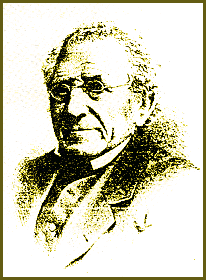 |
Upper Swansea Valley
David "Papa" Thomas
1794-1882
|
|
|
David Thomas was born at Ty Llwyd farm in the hamlet of Wern-Ddu
between Pontardawe and Neath. After a local education he worked
on his father’s farm until 1812 when he commenced work at
the Neath Abbey Ironworks. In 1817 he transferred at the age
of 23 to the Ynyscedwyn Ironworks (see pages on The
Story of Iron) where he stayed for the next 22 years
building a reputation as an ironmaster of note. It was here that
Thomas experimented with ways of using local anthracite instead
of bituminous coal brought in by pack animal or canal. At first
he met with little success but after a visit to the Scottish
engineer James Beaumont Nielson who had patented a hot-blast
system using coke, he persuaded mine owner George Crane to invest
in further experimentation. |
|
From 1836 one furnace at Ynyscedwyn was converted to a hot-blast
system using anthracite. He thus produced the first anthracite
iron in the world and soon had six furnaces using this technique.
An Ynyscedwyn iron pig of this type was exhibited at the Great
Exhibition in 1851. |
|
David Thomas
in later life
Photograph from the collections of the
late
John Morris |
 News of
this development interested the Pennsylvania industrialists who
had large anthracite deposits in that state. After one of their
number visited Ynyscedwyn in 1838, the directors of the Lehigh
Coal and Navigation Company offered David Thomas an opportunity
to develop an ironworks in Pennsylvania. Thomas emigrated with
his family in June 1839 settling in the town of Catasauqua and
had the first anthracite furnace in America working at Pottsville
in January 1840. He was so successful that he founded his own
Thomas Iron Company at Hokenauqua which soon became the biggest
anthracite iron producer in the USA. By 1856 half the iron produced
in the USA was produced using his methods first developed in
Breconshire. News of
this development interested the Pennsylvania industrialists who
had large anthracite deposits in that state. After one of their
number visited Ynyscedwyn in 1838, the directors of the Lehigh
Coal and Navigation Company offered David Thomas an opportunity
to develop an ironworks in Pennsylvania. Thomas emigrated with
his family in June 1839 settling in the town of Catasauqua and
had the first anthracite furnace in America working at Pottsville
in January 1840. He was so successful that he founded his own
Thomas Iron Company at Hokenauqua which soon became the biggest
anthracite iron producer in the USA. By 1856 half the iron produced
in the USA was produced using his methods first developed in
Breconshire. |
|
|
By 1864 the USA was producing more iron than South Wales. Thomas
was president of the American Ironmasters Convention in 1874
and widely revered as the founding father of the American iron
industry. This accounts for the affectionate nickname Papa Thomas.
A furnace museum at Lock Ridge in the Lehigh Valley commemorates
his work. He was widely respected in his home community of Catasauqua
being elected the first burgess of the town when it achieved
incorporation, and running for Congress - albeit unsuccessfully-
in 1866. |
 |
|
 |
|

 News of
this development interested the Pennsylvania industrialists who
had large anthracite deposits in that state. After one of their
number visited Ynyscedwyn in 1838, the directors of the Lehigh
Coal and Navigation Company offered David Thomas an opportunity
to develop an ironworks in Pennsylvania. Thomas emigrated with
his family in June 1839 settling in the town of Catasauqua and
had the first anthracite furnace in America working at Pottsville
in January 1840. He was so successful that he founded his own
Thomas Iron Company at Hokenauqua which soon became the biggest
anthracite iron producer in the USA. By 1856 half the iron produced
in the USA was produced using his methods first developed in
Breconshire.
News of
this development interested the Pennsylvania industrialists who
had large anthracite deposits in that state. After one of their
number visited Ynyscedwyn in 1838, the directors of the Lehigh
Coal and Navigation Company offered David Thomas an opportunity
to develop an ironworks in Pennsylvania. Thomas emigrated with
his family in June 1839 settling in the town of Catasauqua and
had the first anthracite furnace in America working at Pottsville
in January 1840. He was so successful that he founded his own
Thomas Iron Company at Hokenauqua which soon became the biggest
anthracite iron producer in the USA. By 1856 half the iron produced
in the USA was produced using his methods first developed in
Breconshire.